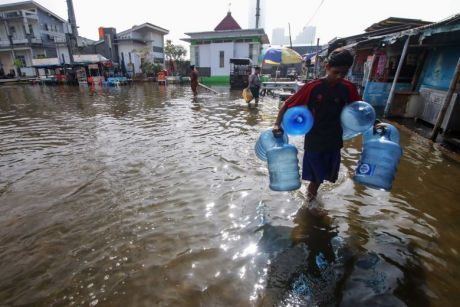News
You are here
Jakarta is sinking: casualty of climate change

August 29, 2019
Jakarta is one of the world’s great cities. The capital of Indonesia is home to about 10 million people. The city proper covers 661 square kilometres; its metropolitan area is almost 10 times bigger, with 30 million inhabitants.
Jakarta is drowning.
Parts of the city have sunk more than 4 metres in recent years. Across the city the ground is sinking several centimetres per year. Flooding is out of control.
Jakarta is built on a river delta area. The sheer weight of the city and its people is causing the ground to compact and sink. The level of the Java Sea is rising, due to global warming. Because of warming seas, rainfall patterns have changed and rivers which converge in Jakarta and flow into the Sea regularly overflow their banks. Storm surges threaten the port.
Jakarta is drowning in salt water in part because it is running out of fresh drinking water. Ceaseless pumping of groundwater reserves accelerates the sinking land.
Rather than spend $ billions in what will be a losing battle, the Indonesian government has announced it is abandoning Jakarta. The new capital will be moved from the island of Java to Borneo.
The move will take place over 10 years. The cost is projected to be $34 billion (US) but that is certain to be a low estimate.
Borneo poses its own problems for the Indonesian government. Unregulated forestry is destroying the rainforests. There is a history of unrest among Indigenous populations forced from their homes by a hydroelectric megaproject.
Unless there is a thorough system change, eliminating the profit motive as the engine of the economy, the move will just recreate the disaster in another place.
Dying cities
What is happening now in Jakarta will happen in the near future in cities like New Orleans, Venice and Singapore. Hundreds of millions of inhabitants will be affected.
New Orleans is sinking, on average, 2 inches a year. Conservative estimates say NO will be 4 metres below sea level by 2100. As water levels rise, dikes and levees will become useless against storm surges and floods. Today about half of the city area is below sea level. The populationof the city proper is only half a million, still too many for the location.
Fresh water is disappearing fast. In some places this results in ground compaction and flooding. In others salt water is seeping into the underground aquifer, poisoning the drinking supply. One way or another the cities are dying.
In South Africa, Cape Town and Johannesburg are running dry. Water resources had to be diverted from irrigating farms and vineyards to the thirsty cities.
In Zimbabwe, drought is killing Harare, a city of 2 million. Water is strictly rationed, with most residents getting access to taps one per week. Lack of clean water for sanitation is resulting in the rise of cholera and other diseases.
The government has to resort to dirtier, contaminated water sources, spending more and more for chemicals to make it tolerably safe.
Beyond great cities, agricultural land is being lost to drought in some areas and rising sea levels in others. Rising seas don’t just mean floods, they result in salinization of aquifers. In particular, the delta areas of the global south that are crucial for rice production are being lost.
Rice production is falling at about 2% a year, and prices are rising faster. In some places salt flooding means farmers are switching from rice to shrimp farming. But aquaculture cannot substitute for the staple food of literally billions of people.
Some projections show that 1 in 5 of the world’s cities will have to be abandoned by the end of the century due to deadly heat waves, rising sea levels and exhaustion of water supplies. When environmental groups like Extinction Rebellion talk about an existential threat to civilization, they are not exaggerating.
Section:










